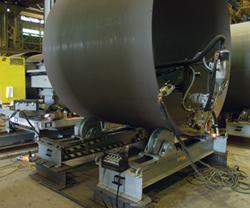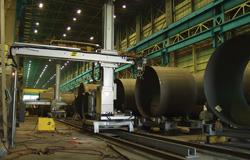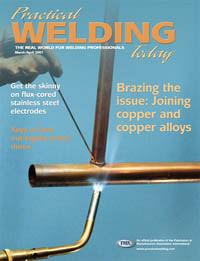- FMA
- The Fabricator
- FABTECH
- Canadian Metalworking
Categories
- Additive Manufacturing
- Aluminum Welding
- Arc Welding
- Assembly and Joining
- Automation and Robotics
- Bending and Forming
- Consumables
- Cutting and Weld Prep
- Electric Vehicles
- En Español
- Finishing
- Hydroforming
- Laser Cutting
- Laser Welding
- Machining
- Manufacturing Software
- Materials Handling
- Metals/Materials
- Oxyfuel Cutting
- Plasma Cutting
- Power Tools
- Punching and Other Holemaking
- Roll Forming
- Safety
- Sawing
- Shearing
- Shop Management
- Testing and Measuring
- Tube and Pipe Fabrication
- Tube and Pipe Production
- Waterjet Cutting
Industry Directory
Webcasts
Podcasts
FAB 40
Advertise
Subscribe
Account Login
Search
Up with energy prices and wind towers
Automation, consultation help plate fabricator meet demand for wind tower masts
- By Sue DiBianca
- March 13, 2007
- Article
- Arc Welding
The recent surges in gasoline and natural gas prices have reawakened many Americans' interest in alternative energy resources. Aerisyn LLC, a metal fabricator, faced the energy challenge head-on by opening a new wind tower manufacturing facility in Chattanooga, Tenn., in August 2005.
It had good reason to—wind power was already growing, even without the big increases in energy prices. According to the Energy Information Administration (EIA), wind power in the U.S. increased nearly sevenfold in 15 years, growing from 22 trillion British thermal units (BTU) in 1989 to 143 trillion BTU in 2004.
Technology improvements are partly responsible for the growth in wind energy. In the 1970s, wind towers earned their reputation for being noisy and ugly. Today's wind towers, however, are five or six generations removed from the first designs. They are larger, slower, and quieter than their predecessors.
They also are much more efficient. Taller towers reach higher into the atmosphere to take advantage of stronger air currents, so one new turbine today can produce the same amount of energy as 10 to 20 of the first-generation towers. An average wind turbine today produces between 1.5 megawatts (enough for 600 homes) and 2.8 megawatts.
Fabricating these taller towers, however, can be a challenge. The few existing U.S. wind tower manufacturers cannot meet current demand in North America, so U.S. energy companies have been forced to purchase towers from Asia. Aerisyn feels it could triple its manufacturing capacity and still not meet domestic demand. To keep the company productive enough to meet this growing demand and efficient enough to compete with Asian manufacturers, Aerisyn developed an automated production line.
An Idea Grows Into an Opportunity
Aerisyn determined that it wanted to develop a sophisticated, consistent joining process for assembling wind towers, which are made by welding together a series of large cylindrical cans. To do this, Aerisyn's staff needed to work with a partner with significant expertise in welding. It found a supplier, ESAB, that had experience in fields with demanding requirements—aerospace and nuclear—and wind towers.
Aerisyn intended to build a new facility until it learned of a plant for lease in Tennessee. The facility had been used to build nuclear reactors and for other heavy fabrication. The plant not only offered the space Aerisyn needed, it was also located near railways and waterways. This solved one of the key problems wind tower manufacturers face: transporting the final product. An average wind tower section is 14 feet in diameter, 50 to 100 ft. long, and weighs up to 50 tons. A completed tower stands 260 ft. to 320 ft. high.
The other major challenge Aerisyn faced was the need to keep its operating costs down to compete with the Asian manufacturers.
To do so, the company focused on developing a highly automated process. Nevertheless, skilled and talented people are critical to the company's success. The fabrication process focuses on welding, and Aerisyn knew it needed talented welders who understand what happens when metals melt. Although the new automated equipment allowed Aerisyn to rely on fewer people, the company hired and trained the best talent it could find to operate the equipment.
ESAB not only supplied all the cutting, welding, assembly, and material handling equipment for the plant, it also helped Aerisyn develop the welding procedures and was instrumental in designing the plant layout and material flow.
Cut, Bevel, Bend, Weld
A key to producing superior-quality wind towers is the ability to produce dimensionally accurate parts with precise weld preparation beveling on all sides. The fabricating process at Aerisyn begins on one of two ESAB Avenger gantry cutting machines. One machine has a 32-ft. by 109-ft. cutting table with twin heads that allow Aerisyn to cut two 10-ft. by 10-ft. high-tensile-steel plates at the same time, while two more plates are loaded onto the table. This machine is equipped with oxyfuel cutting and beveling heads and is used to cut heavier 2.5-in. plate. A second machine has a 14-ft.-wide by 109-ft.-long table and is equipped with plasma cutting and beveling heads to cut plate up to 1 in. thick.
Both machines have programmable capabilities to cut parts and bevel edges in a seamless operation. The software simplifies setup time, and the accuracy and repeatability reduce the need for secondary cleanup operations. These machines are equipped with an optical troubleshooting system that allows an ESAB technician to "see" the machine in operation and instruct the Aerisyn operator on repairs if a problem should arise.
Having the cutting machines in-house reduces the company's lead-time by four to eight weeks, according to Aerisyn. Most of its U.S. competitors have outsourced their cutting operations. If they discover a fault in the metal, it may take weeks to get a new piece cut. Aerisyn can cut a new part and get production back up and running in a matter of hours.
According to the National Renewable Energy Laboratory (NREL), the U.S. can generate more than 10,000 megawatts of electricity from the wind, which is enough to power 2.5 million average American homes. Experts predict that wind energy, with proper development, could provide 20 percent of this nation's energy needs. Source: www.nrel.gov
The U.S. Department of Energy Efficiency and Renewable Energysays the U.S. installed more new wind energy capacity than any other country in 2005. Source: energy.gov
The American Wind Energy Associationestimates that the top 20 states for wind energy potential, in billions of kilowatt-hours per year, are:
- North Dakota: 1,210
- Texas: 1,190
- Kansas: 1,070
- South Dakota: 1,030
- Montana: 1,020
- Nebraska: 868
- Wyoming: 747
- Oklahoma: 725
- Minnesota: 657
- Iowa: 551
- Colorado: 481
- New Mexico: 435
- Idaho: 73
- Michigan: 65
- New York: 62
- Illinois: 61
- California: 59
- Wisconsin: 58
- Maine: 56
- Missouri: 52
Source: www.awea.org
After the pieces are cut, they are run through a plate blaster to remove mill scale and primer, rolled into a can, manually tack welded, and loaded onto an automatic welding station. A column-and-boom submerged arc welding (SAW) system welds the external and internal longitudinal seams. Mounting flanges are also welded onto the can ends at this station. A fully integrated controller operates the welding head and the column and boom, the wire feeders, and the flux recovery system.
The can then moves to a head- and tailstock positioner with motorized rotation and hydraulic height adjustment. The first can is clamped into the tailstock. The next can then is clamped into the headstock in a corresponding manner, and the cans are positioned using the ESAB support roller bed and manipulators. The two cans then are tightened together and tack welded before the automatic SAW equipment welds the circumferential seams. A column-and-boom station welds the external seams while a tractor welder does the internal seams. Can by can, the section grows until it reaches its final 50- to 100-ft. length. A built-in rounding jig maintains the proper roundness. Like the longitudinal seam welding station, the circumferential seam welding station uses an integrated control. An optical monitoring system allows the operator to see the weld seam throughout the process.
After fabrication, all electrical equipment, ladders, lighting, controls, and platforms are added to the tower sections so they are ready to be installed in the field.
Towering Over Traditional Energy Sources
A key focus at Aerisyn has been to make wind towers taller but not heavier. For that to happen, the welded joints must be as strong as the parent metal. The weld must become part of the structure. According to the company, the level of confidence Aerisyn's customers now have in the welds' consistency has allowed Aerisyn to reduce its testing from ultrasonic testing of 100 percent of the welds to 20 percent. This is an enormous time-saver for the company.
Aerisyn is currently working on improvements in the welds. The company's goal is to reduce the cost of a wind turbine by 2 percent. This may not seem like much, but this savings will be enough to make wind energy more economical than oil, natural gas, or nuclear.
How will future demand for wind towers pan out? That's hard to tell, but the EIA predicts wind-generated electricity itself will grow from 9.62 gigawatts in 2005 to 17.98 gigawatts in 2030.
Aerisyn LLC, 1025 W. 19th St., Chattanooga, TN 37408, 423-648-3884
About the Author
About the Publication
Related Companies
subscribe now

The Welder, formerly known as Practical Welding Today, is a showcase of the real people who make the products we use and work with every day. This magazine has served the welding community in North America well for more than 20 years.
start your free subscription- Stay connected from anywhere

Easily access valuable industry resources now with full access to the digital edition of The Fabricator.

Easily access valuable industry resources now with full access to the digital edition of The Welder.

Easily access valuable industry resources now with full access to the digital edition of The Tube and Pipe Journal.
- Podcasting
- Podcast:
- The Fabricator Podcast
- Published:
- 04/16/2024
- Running Time:
- 63:29
In this episode of The Fabricator Podcast, Caleb Chamberlain, co-founder and CEO of OSH Cut, discusses his company’s...
- Industry Events
16th Annual Safety Conference
- April 30 - May 1, 2024
- Elgin,
Pipe and Tube Conference
- May 21 - 22, 2024
- Omaha, NE
World-Class Roll Forming Workshop
- June 5 - 6, 2024
- Louisville, KY
Advanced Laser Application Workshop
- June 25 - 27, 2024
- Novi, MI


































